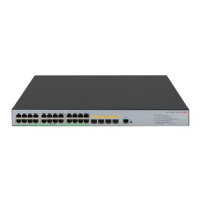286
To realize such requirements, you can enable the IPv6 multicast group replacement function on the switch
or on a certain port. When the number of IPv6 multicast groups that the switch or the port has joined
reaches the limit, one of the following occurs:
• If the IPv6 multicast group replacement feature is disabled, new MLD reports are automatically
discarded.
• If the IPv6 multicast group replacement feature is enabled, the IPv6 multicast group that the switch
or the port newly joins automatically replaces an existing IPv6 multicast group that has the lowest
IPv6 address.
IMPORTANT:
Be sure to configure the maximum number of IPv6 multicast groups allowed on a port (see "Setting the
maximum number of mult
icast groups that a port can join)" before enabling IPv6 multicast group
replacement. Otherwise, the IPv6 multicast group replacement functionality will not take effect.
Enabling IPv6 multicast group replacement globally
Ste
Command
Remarks
1. Enter system view.
system-view N/A
2. Enter MLD-snooping view.
mld-snooping N/A
3. Enable IPv6 multicast group
replacement.
overflow-replace [ vlan vlan-list ] Disabled by default
Enabling IPv6 multicast group replacement for a port
Ste
Command
Remarks
1. Enter system view.
system-view N/A
2. Enter Layer 2 Ethernet
interface view, Layer 2
aggregate interface view, or
port group view.
• Enter Layer 2 Ethernet interface
view or Layer 2 aggregate
interface view:
interface interface-type
interface-number
• Enter port group view:
port-group manual
port-group-name
Use either command.
3. Enable IPv6 multicast group
replacement.
mld-snooping overflow-replace
[ vlan vlan-list ]
Disabled by default.
Setting the 802.1p precedence for MLD messages
You can change the 802.1p precedence of MLD messages so that they can be assigned higher
forwarding priority when congestion occurs on their outgoing ports.
Setting the 802.1p precedence for MLD messages globally

